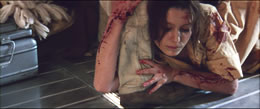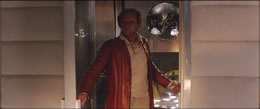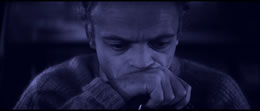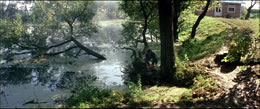
Color, 1972, 166m.
Directed by Andrei Tarkovsky
Starring Donatas Banionis, Natalya Bondarchuk, Nikolai Grinko
Criterion (Blu-Ray & DVD) (US RA/R1 HD/NTSC), Artificial Eye (UK R2 PAL), Shock (Australia R4 PAL) / WS (2.35:1) (16:9), Ruscico (Russia R0 NTSC) / WS (2.35:1) (16:9) / DD5.1
Loosely based on the well-known novel by Stanislaw Lem (and subject of a flawed but intriguing remake by Steven Soderbergh), this infuential Russian science fictoin/art film begins with the countryside reverie of scientist Chris Kelvin (Banionis), a scientist sent to investigate the strange occurrences plaguing the Solaris mission. Aboard a space station hovering over an oceanic planet, one scientist has already died, and the other two survivors are less than forthcoming with the details of their experience. A former cosmonaut had already told Kelvin about the strange influence of the Solaris waters on the human consciousness, but only when he witnesses firsthand the physical manifestation of his memories and desires does Kelvin begin to believe the claims that these are no ordinary waters below. Adding further confusion to his discovery is the appearance of Hari (Bondarchuk), who may be his wife reincarnated... or something else entirely.
Though the director had issues with the novel's author and his cast, Solaris remains the best known effort by influential and controversial director Andrei Tarkovsky (The Mirror, Nostalghia). Through overlapping memories, fantasies, surprising dashes of surrealistic horror, and sparingly used fantastic visuals, Tarkovsky deliberately subverts expectations by delivering a space film more concerned with the inner workings of the human soul and psyche than the mechanics of flying ships. As with other Tarkovsky films, Solaris is deliberately paced from start to finish, driven more by its heady atmosphere and delicate visuals than the demands of a typical linear plot. The framework of Lem's novel (with an added first act by Tarkovsky) allows a flowing series of meditations on man's emotional nature and his often dangerous ties to the past, while the actors perform their often challenging roles with exquisite restraint and intensity. The startling interjections of colorful, stylized images (the swirling multi-colored, cloud-like waters, the sun glistening off damp trees, the slick transition from black and white footage to color as a car speeds through a tunnel) are accompanied by a haunting recurring Bach motif and a potent score by Eduard Artemiev; in fact, you'd be hard pressed to even guess this was a science fiction film based on the first half hour. Hypnotic and challenging, this is certainly not a film for all viewers (those who find 2001 slow will be crawling the walls), but the rewards for the faithful will be plenty.

Frequently hacked down after its initial release and mistreated during most of the VHS era with shoody and croppoed transfers, Solaris received a long overdue theatrical reissue in its complete form during the 1980s and was issued on VHS and (in a more accurately letterboxed rendition) on laserdisc by Fox Lorber. Its DVD debut came courtesy of Ruscico's two-disc set, which boasts a colorful and crisp anamorphic presentation spread over both platters (for whatever reason) along with a 5.1 remix. Though gimmicky and obviously not true to the director's intentions, the audio track may be more accessible for impatient viewers as it jazzes up new life into scenes which previously felt like static filler. Menu options are available in English, Russian, or French, while the film is viewable in 5.1 mixes of all three languages (the original Russian with English subtitles works best, but the dubs are also very well done). The disc also contains trailers for Tarkovsky's Andrei Rublev and The Mirror (both available on domestic DVD) and the excellent Russian "western," At Home with Strangers - A Stranger Among His Own, as well as Investigation of Pilot Pirx (a snippet of another Lem adaptation), video interviews with Bondarchuk and Tarkovsky's family, and a featurette dedicated to Banionis with some interesting ties to the film itself.
However, Tarkovsky fans and newcomers alike will find Criterion's set both easier to find and a more informative crash course in this notoriously challenging director. They inititally released it as a double-disc DVD in 2002; confined to the first disc (allowing continuous viewing despite the two-part structure), the film itself features an audio commentary by Vida Johnson and Graham Petrie, authors of The Films of Andrei Tarkovsky: A Visual Fugue. Scholarly in tone, the discussion is extremely dry but contains some valuable nuggets of information about the film's often elliptical symbolism and rarely stops for breath. The second disc commences with a whopping twenty minutes of excised footage, some entire scenes scrapped from the final cut and the others extensions of sequences from the film. Bondarchuk turns up again for a half hour interview (with optional subtitles) in which she offers much of the same information about working with Tarkovsky, but this time other video interviews include cinematographer Vadim Yusov, art director Mikhail Romadin, and composer Eduard Artemyev, with the interview totals clocking in at well over 90 minutes. A clip from a European television documentary features Lem discussing the film's adaptation of his work in less than glowing terms; one can only wonder how he felt about other attempts to bring his written words to the screen. Finally, the fold-out booklet contains an essay by film critic Phillip Locate (which includes an interesting parallel to Vertigo) and a bit of analysis from Akira Kurosawa. (Interestingly, neither DVD features the original Solaris trailer, which does pop up on other Ruscico discs.)
In May 2011, the film was reissued by Criterion on with a new HD transfer from the original negative and completely new (superior) cover art, porting over the same extras. More importantly, however, it also marked the film's Blu-Ray debut in a stunning, vibrant transfer that blows away its  standard def counterparts by a tremendous margin. The amount of detail is a welcome leap forward and perfectly captures the feel of watching the film in 35mm, with extremely fine grain giving it that distinctive '70s sheen. Click on any of the images in this review for an idea of how much better this looks in 1080p; it's really something special, right from the deep green and finely detailed foliage in the opening shots. Some extremely fine, tiny scratches pop up around the 74 minute mark, but considering standard def wouldn't have even revealed them at all, it's barely worth noting. What's also fascinating about this version is the restoration of the color tinting to the black and white sequences, which now alternate between a blue tint (used for the majority of the footage) and a pale, steely lavendar (some of the freeway shots). The previous Ruscico and some other video versions displayed the tints in varying degrees of intensity, while many theatrical prints did not; the film's cinematographer initially said back in 2002 that the footage was shot monochromatic and intended to be left that way, but as one restored shot during the freeway scene proves here, that isn't possible as the gradually escalating purple slowly blooms into full color. It's a powerful effect and nice to have here again. For fans of this film, it's certainly worth an upgrade; for newcomers, there's no better way to make the acquaintance of this challenging but deeply rewarding film.
standard def counterparts by a tremendous margin. The amount of detail is a welcome leap forward and perfectly captures the feel of watching the film in 35mm, with extremely fine grain giving it that distinctive '70s sheen. Click on any of the images in this review for an idea of how much better this looks in 1080p; it's really something special, right from the deep green and finely detailed foliage in the opening shots. Some extremely fine, tiny scratches pop up around the 74 minute mark, but considering standard def wouldn't have even revealed them at all, it's barely worth noting. What's also fascinating about this version is the restoration of the color tinting to the black and white sequences, which now alternate between a blue tint (used for the majority of the footage) and a pale, steely lavendar (some of the freeway shots). The previous Ruscico and some other video versions displayed the tints in varying degrees of intensity, while many theatrical prints did not; the film's cinematographer initially said back in 2002 that the footage was shot monochromatic and intended to be left that way, but as one restored shot during the freeway scene proves here, that isn't possible as the gradually escalating purple slowly blooms into full color. It's a powerful effect and nice to have here again. For fans of this film, it's certainly worth an upgrade; for newcomers, there's no better way to make the acquaintance of this challenging but deeply rewarding film.
Reviewed 5/10/11.
![]()
